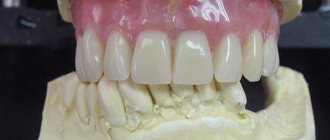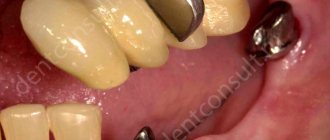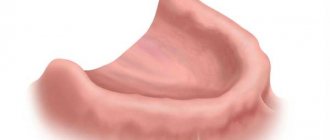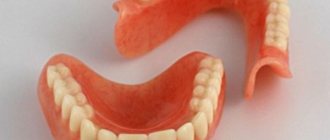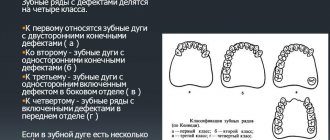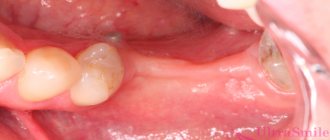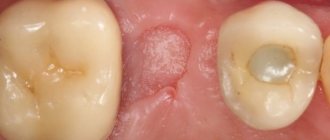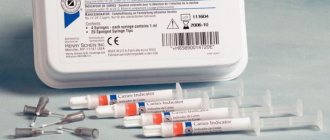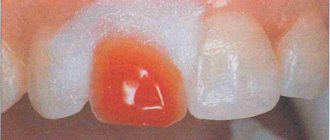Author of the article:
Anastasia Vorontsova
Photo: Clasp prosthesis with attachments
Clasp prosthetics with attachments
is currently the modern and most popular removable orthopedic design.
Clasp dentures give the patient a chance to acquire a beautiful smile. The structure is attached using clasps (attachments) to artificial crowns, implants or tooth roots.
The clasp prosthesis on attachments is motionless and the main part of the load is distributed on the supporting teeth, thanks to the presence of a metal arched frame made of a good alloy.
Thanks to the attachments, the removable denture is fixed in the oral cavity, its retention and stabilization is ensured.
The design on attachments is securely held on the prosthetic bed, while the elements of the clasp prosthesis interact physiologically.
Types of attachments
According to manufacturing technology, attachments can be divided into groups:
- Metal - they are standard.
- Plastic - made individually.
Depending on the location of the lock, the attachments are:
Photo: Clasp attachments on the upper jaw
- Extracoronal.
- Intracoronal.
- In the form of root pins.
- Crossbars.
- Rod
- Globular.
- Rail.
The most common fastening of attachments is spherical.
- Depending on the type of transmission of chewing load to the structure and supporting teeth, attachments can be: rotational, rigid, hinged.
- By connection method: magnets, mechanical retention, screws, friction.
Structure of attachments
Photo: Elements of locking fixation
The clasp design consists of a frame made of metal and artificial gum, shaped like a saddle. The structure is attached to the supporting teeth using attachments.
Attachments consist of parts:
- Patrix - which is located on the supporting tooth, crown, implant or root.
- Matrix - located on the dental structure.
After putting on the structure, the attachments snap into place, which ensures reliable fixation.
When installing the structure, it must be remembered that loose teeth cannot serve as a support for the prosthesis.
Among attachments, the most popular is the spherical mount, where the male is a metal ball, and the matrix is made of plastic in the form of a cavity. The parts are connected by enveloping the matrix around the ball and snapping it into place.
The clasp design on attachments with a ball-shaped fastening is in great demand due to its reliability and naturalness, in the case of a well-chosen shade of artificial teeth.
Differences between clasp dentures and other types of dentures
As we said above, the main difference between this type of prosthesis and prostheses made of acrylic plastic and nylon is the presence of a cast metal frame (Fig. 2). After the frame is ready, a base is welded onto it, which can be made of pink plastic or nylon. Next, artificial teeth made of plastic are fixed to the base, and the prosthesis is ready.
Due to the presence of a strong metal frame made of cobalt-chromium alloy, it is possible to significantly reduce the volume and thickness of the base on which artificial teeth are fixed. Figures 7-8 show how clasp dentures differ in size from traditional dentures made of acrylic plastic. These differences are especially noticeable in the area of the front teeth and on the palate, where the clasp denture does not have a massive bridge, but only a thin metal arch.
Comparison of acrylic and clasp dentures –
Important: the base of the clasp denture is traditionally made of pink acrylic plastic. However, if desired by the patient, it can also be made of either nylon or Acry-Free material. This is a new generation material (unlike nylon - it is only slightly elastic, which is good for optimal distribution of the chewing load on the gums). In general, complete and partial removable dentures are made from this material, but the base of a clasp denture can also be made from this material (though this will cost a little more).
Advantages
The advantages of fastenings on attachments include the following:
Photo: Aesthetics of a clasp denture on attachments
- High aesthetic effect.
- Stable and durable fixation of the structure.
- Uniform distribution of loads over the surface of the supporting teeth.
- The materials from which the attachments are made are standard, so there is a choice of replacements.
- Ease of use.
- Feels comfortable when using.
- The prosthesis is not visible to others, and therefore has high aesthetics.
- Shorter period of getting used to the design.
- Possibility of replacing structural parts.
- No problems with diction.
- Long service life.
- Quick adaptation to this type of design.
- The frame of the structure is made of biocompatible material.
Are there any contraindications
Despite the abundance of advantages, prosthetic structures with locks have a number of installation restrictions. Here are the main contraindications:
- the supporting elements are severely damaged and will not be able to provide reliable fixation,
- there are pockets of inflammation on the roots of the remaining teeth,
- severely exposed roots are a consequence of periodontal disease,
- small crown height (up to 5 mm),
- Parkinson's disease, arthritis and other diseases that limit the mobility of the hands and significantly complicate the process of removing and installing a prosthesis with a complex attachment mechanism.
You should not resort to this type of prosthetics if you do not have the opportunity to see your dentist at least once every six months. It is also necessary to provide high-quality oral care, including before installing an orthopedic device. To do this, experts recommend undergoing professional cleaning to remove plaque and deposits in advance.
Nuances of prostheses with attachments
In order for removable dentures with attachments to work for a long time, you need to protect them from increased load, otherwise they will be crushed. And premature failure means poor retention of the prosthesis.
This is interesting: Glue for dentures: how to glue them at home
For this purpose, the supporting crowns are milled. So that the entire chewing load is transferred to the supporting platform, and not to the attachment. There can be at least two sites, or more.
Correctly manufacturing a prosthesis using attachments is not an easy task. It is necessary to accurately assess the condition of the roots of the teeth - what load on them will be adequate. So that the removable denture does not affect the condition of the tooth, its root and the bone surrounding it. And it was not the cause of premature tooth loss. To do this, you need to additionally evaluate the condition of the teeth on the opposite jaw. Since complete preservation of the teeth will allow the patient to develop a greater load, and vice versa, the presence of a removable denture on the antagonist jaw will reduce the load on the teeth of the opposite jaw. Therefore, before you decide on prosthetics with removable dentures with attachments, first consult your doctor - he will tell you in detail during the consultation about all types of dentures that can be used in your case, their pros and cons. Together with him you will choose the best option.
Attachments can be used in clasp dentures for end defects
So with large absence of teeth:
On the beams on the roots of the remaining teeth
On implants
Indications
Installation of clasp dentures on attachments is preferable in the following cases:
Photo: Absence of teeth - an indication for clasp prosthetics
- Unilateral and bilateral terminal defects of teeth.
- Multiple dental defects.
- Impaired chewing and diction due to the absence of one or more teeth.
- Pathological abrasion of teeth.
- Periodontal diseases.
- With pronounced maxillary tubercles.
- Having a flat sky.
- Diabetes disease.
- Blood diseases expressed by decreased resistance of gum capillaries.
- Inability to install permanent dentures.
- Teeth grinding (bruxism).
- Malocclusion.
- Bad aesthetics.
- Atrophic changes in the alveolar processes, in the absence of the possibility of using a plate denture.
Reviews
Reviews from some patients who use clasp dentures with attachments:
- I had a clasp denture installed with attachments three years ago, and I still use it with pleasure. It doesn’t rub anywhere, it attaches unnoticeably and easily, I don’t take it off at night. The design is comfortable and lightweight.
- As I got older, I lost a lot of teeth. A year ago I installed a clasp prosthesis with attachments. It took me a long time to get used to this design. The prosthesis is firmly fixed, lightweight, and easy to use. I don't take it off at night. The teeth look like real ones.
- I had a denture installed with attachments a year and a half ago. Everything was fine. Two months ago there were complaints of pain in the area of the supporting teeth in the lower jaw, and a little later they became mobile.
- I have been suffering from periodontal disease for more than ten years. I use a clasp denture with attachments. It took me a long time to get used to it. The dentist advised not to remove the structure at night. Now everything is fine.
- I placed a removable clasp denture on attachments. I got used to it within a week. The design looks impressive, the mouth is full of snow-white teeth. I didn’t have such teeth even at a young age.
Manufacturing of dentures with locking fastening
Before starting to make dentures, the doctor performs dental treatment and prescribes home treatment for gums. When the condition of the oral cavity is in perfect order, the specialist performs a lot of clinical and laboratory tests. After making prostheses with locking fastening, the doctor installs them for the patient, but does not fix them. This procedure allows you to obtain accurate impressions of teeth and gums, which will subsequently ensure the manufacture of comfortable fixed dentures. After such fitting, prostheses are made that correspond to the impressions obtained. The finished dentures are securely installed in the patient’s mouth.
This is interesting: Is it necessary to remove dentures at night: types of dentures, material, rules of use and storage, oral hygiene and dental advice
In modern dentistry, tooth roots are often used in prosthetics. This procedure is called intraradicular prosthetics, in which fastening locks are installed directly into the roots. This method allows you to significantly increase the functional capabilities of the prosthesis and evenly distribute the chewing load throughout the entire oral cavity. Intraradicular prosthetics looks aesthetically pleasing and, due to its characteristics, increases the service life of the structure.
Installed dentures with locking fastenings do not create discomfort in the oral cavity, return a person to a beautiful smile and allow him to feel the joy of eating.
Prices
The cost of clasp dentures with attachments is quite high. It depends on the quality and quantity of the material used to manufacture the structure and the complexity of the work.
The price of a one-sided design will be from 5,500 to 83,000 rubles, and a double-sided design will be from 19,000 to 124,000 rubles.
The price includes the price of the prosthesis, attachments and crowns.
| Type of clasp prosthesis | Price in rubles |
| Prosthesis with 2 – 3 clasps | 39000 |
| Splinting design | 39500 |
| Prosthetics of a single-end defect with the “MK-1” attachment | 70000 |
| Design with attachment for double-ended defect “MK-1” | 82000 |
| Prosthetics with “Bredent” attachments | 72000 |
The final cost of manufacturing a denture using this technology will be determined by the city and the status of the dental clinic.
Product care rules
In order for the product to last as long as possible, patients must follow certain rules for caring for it. The structure is cleaned daily with a soft brush to remove food debris and plaque. The denture is removed from the mouth before standard oral hygiene procedures in the evening and morning.
After eating, the denture is thoroughly rinsed with warm running water. Once a day, the structure is treated with antiseptic solutions, which protect metal parts from corrosion and destroy pathogenic microorganisms. The antiseptic for treating the prosthesis is selected depending on the model and brand of the system. Once a week, the device is soaked in a container of liquid overnight.
Store the bulgel in a special container with a lid to avoid contamination.


